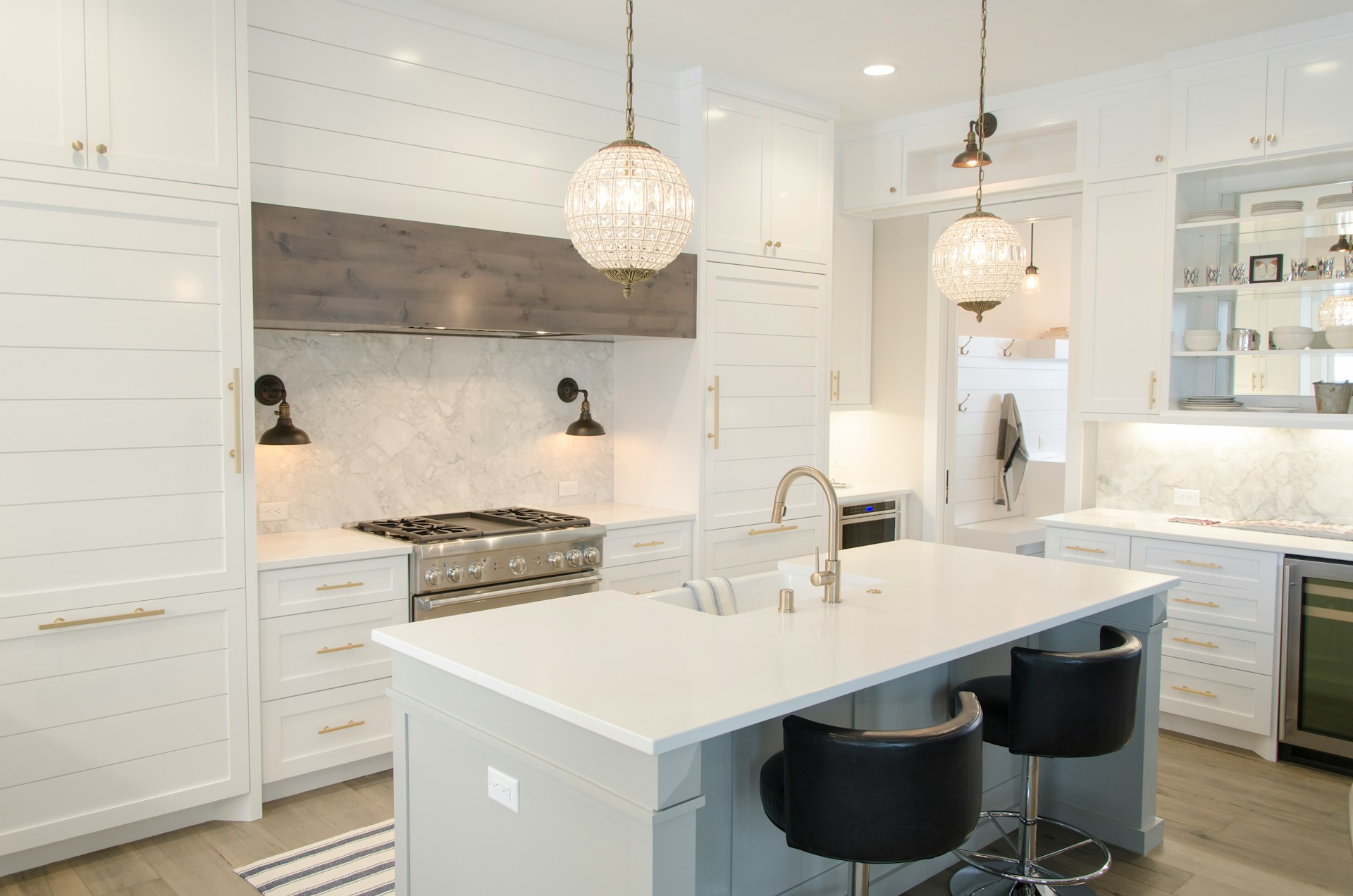Lighting plays a crucial role in every household, more so in rooms where you spend most of your time like the kitchen. The right balance of artificial and natural light can transform your kitchen into a warm and inviting space. This article sets out to guide you on how to achieve that perfect balance between artificial and natural lighting, creating the ultimate ambiance in your kitchen.
Understanding the Importance of Natural Light
Before diving into how to achieve a balance between artificial and natural lighting in your kitchen, it’s essential to understand the importance of natural light. Natural light is the primary source of lighting during the day. Its value goes beyond merely illuminating your spaces.
Topic to read : What are the best materials for a kitchen backsplash that resists mold?
Studies have shown that exposure to natural light boosts mood, productivity, and overall well-being. Natural light also helps in making spaces look larger and more welcoming. In kitchens, natural light is essential for tasks like cooking and cleaning.
When planning your kitchen, consider elements like windows, skylights, and doors that can let in maximum natural light. However, it’s not about letting in all the light you can. It’s about controlling and harnessing it for the best results.
Also to discover : How can multi-color LED lights transform the ambiance of a kitchen?
The Role of Artificial Light in the Kitchen
While natural light is the hero during the day, artificial light takes over as darkness sets in. The role of artificial light in the kitchen is indispensable. It is not only functional but also plays a significant role in setting the ambiance of the space.
There are three types of artificial lights that you can incorporate into your kitchen: ambient, task, and accent lighting. Ambient light provides overall illumination, task light focuses on certain work areas like countertops, while accent light highlights certain elements like open shelving or artwork.
By understanding the role of each type of artificial light, you can ensure your kitchen is well-lit at all times. Remember, the goal is not to flood your kitchen with light but to create a balance that promotes functionality and aesthetics.
Achieving the Perfect Balance
Now that we understand the importance and role of both natural and artificial light, let’s dive into how to create a balance between the two.
One of the best ways to achieve a balance is by using daylighting controls. These are systems that adjust the amount and quality of artificial light in response to the amount of natural light available. They can include sensors, timers, and dimmers that work together to create the perfect lighting environment.
You can also balance lighting in your kitchen by carefully selecting window treatments. Opt for light-filtering shades or blinds that can control the amount of natural light entering your kitchen.
Overcoming Common Lighting Mistakes
In your quest to achieve the perfect balance between artificial and natural kitchen lighting, you’re likely to encounter some common pitfalls. Avoiding these can help you enhance the overall lighting experience in your kitchen.
One common mistake is relying too much on one type of lighting. A kitchen lit solely by overhead fixtures may appear harsh and unwelcoming. On the other hand, task lighting alone may not provide enough illumination for the entire kitchen.
Another mistake to avoid is neglecting the color of your lights. Different lights have different color temperatures, affecting how the colors look in your kitchen. Warmer lights tend to make spaces feel cozy while cooler lights make spaces feel more energetic.
Remember, striking the perfect balance between artificial and natural kitchen lighting is not about achieving perfection. It’s about understanding your space, your needs, and using light to create a kitchen that’s functional, aesthetically pleasing, and warm.
Incorporating Lighting Design Trends
As you aim to achieve the perfect balance between artificial and natural kitchen lighting, it’s worth keeping an eye on current lighting design trends. These trends can provide inspiration and innovative solutions for your kitchen lighting dilemmas.
One of the notable trends is the increased use of LED lights. These are not only energy-efficient but also come in a variety of color temperatures, making them ideal for every kitchen.
Another trend is the use of pendant lights over kitchen islands. These not only provide task lighting but also contribute to the overall design aesthetic. Similarly, under-cabinet lighting is gaining popularity for its ability to illuminate countertops without creating harsh shadows.
Embracing these trends can help you create a modern, energy-efficient kitchen with the perfect balance of artificial and natural light. It’s all about making the best use of the available light, enhancing your kitchen’s functionality, and creating a space that’s inviting and comfortable to work in.
Considering the Impact of Kitchen Colors and Surfaces
As we continue to delve into the perfect balance between artificial and natural kitchen lighting, it’s essential to consider one crucial factor: the colors and surfaces in your kitchen. These elements play a significant role in how light behaves in your space.
Light colors reflect light, making spaces appear brighter and larger, while dark colors absorb light, creating a cozy, intimate atmosphere. Therefore, your choice of wall colors, cabinet finishes, and countertop materials can greatly affect the overall lighting in your kitchen. For instance, white or light-colored cabinets and walls can help maximize natural light during the day, reducing the need for artificial lighting.
Reflective surfaces such as glossy tiles, stainless steel appliances, and polished granite countertops can also enhance lighting in your kitchen. They reflect both natural and artificial light, evenly distributing it across the room. Conversely, matte surfaces absorb light, reducing reflection and glare.
It’s also worth noting that the color of your lights can dramatically alter the perception of colors in your kitchen. Warmer light brings out the rich tones of wood and other warm-colored materials, while cooler light can enhance the appearance of white and cool-colored surfaces.
Remember, achieving a balance between artificial and natural kitchen lighting goes beyond the light sources. It involves understanding how colors and surfaces interact with light to create an inviting and functional kitchen.
Conclusion: Creating the Perfectly Lit Kitchen
Having explored the importance of natural light, the role of artificial light, and the impact of colors and surfaces, you’re now equipped to create a kitchen with the perfect balance of lighting. Achieving this balance doesn’t require you to be an expert in lighting or interior design. It’s about understanding your space and needs, and making informed decisions.
One of the crucial factors to remember is to avoid relying too much on one type of lighting. Strive to have a mix of natural light, ambient lighting, task lighting, and accent lighting to ensure your kitchen is well-lit at all times. Also, consider using daylighting controls to automatically adjust your artificial lighting based on the amount of natural light available.
Embrace the use of energy-efficient light sources like LED lights, which not only save on your energy bills but also provide high-quality light in different color temperatures. Don’t be afraid to experiment with lighting design trends such as pendant lights and under-cabinet lighting.
Finally, consider the colors and surfaces in your kitchen. Opt for light colors and reflective surfaces to enhance natural and artificial light, and choose light colors that complement your kitchen’s color scheme.
Achieving the perfect balance between artificial and natural kitchen lighting is a rewarding endeavor. It not only enhances the functionality and aesthetics of your kitchen but also contributes to your overall well-being. So, take the time to understand your kitchen lighting needs and make the necessary changes to create the perfectly lit kitchen you desire.






